Pure plant perfumes release their scents through specialized cells containing enzymes that produce fragrant molecules like monoterpenes and geraniol. You'll find that these scents aren't just passively released – plants actively transport volatile compounds using ABC transporters, which control emission based on environmental factors like temperature and humidity. Special transport systems guarantee the scents reach their intended destinations efficiently. Understanding these natural mechanisms reveals nature's sophisticated approach to fragrance.
The Secret Science Behind Plant Scent Production
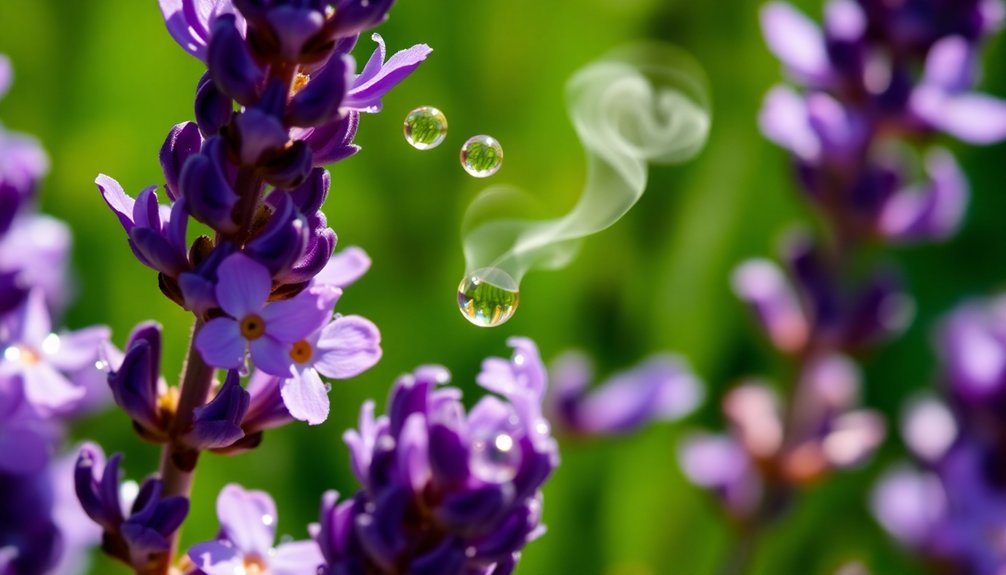
While many people appreciate the enchanting scents of flowers, few understand the complex biological machinery that creates these fragrances. Inside each petal, specialized cells contain enzymes that act as tiny perfume factories, producing signature molecules like monoterpenes and geraniol.
You'll find that roses, in particular, use a unique biosynthetic pathway involving the NUDX1 enzyme to create their distinctive scent.
Once produced, these fragrant compounds don't simply drift away – they're actively transported through the cells and released into the air through biological mechanisms. It's not just about smelling nice; these volatile compounds serve essential functions in plant communication, defense, and reproduction. Different plants create diverse scent profiles through terpenes and terpenoids.
The size and shape of these molecules determine how quickly they evaporate, creating the layered experience you enjoy in natural flower scents.
Understanding Plant Volatile Organic Compounds
You'll discover that plants don't simply let their scents drift away passively, but instead use sophisticated biological transport systems to move volatile compounds through their cells.
These natural fragrance molecules must navigate through complex cellular barriers, including the water-filled cell wall and waxy outer layer, before reaching the atmosphere.
While scientists once thought simple diffusion was responsible for scent release, we now know that plants actively control and regulate their VOC emissions through specialized mechanisms triggered by environmental factors. Specialized proteins called ABC transporters pump these aromatic molecules across cell membranes to control their release.
Natural Scent Release Mechanisms
Plants employ sophisticated biological mechanisms that far exceed simple diffusion when releasing volatile organic compounds (VOCs) into the environment. You'll find that cells use specialized molecular transport systems to move these scents outward, preventing toxic buildup that would occur if they relied on diffusion alone.
When you examine the process closely, you'll notice that plants actively regulate both the timing and quantity of VOC release. This control serves multiple purposes: it helps coordinate internal growth, optimizes resource usage, and enables communication with other organisms. These natural compounds are often extracted through steam distillation methods to create essential oils.
Through KAI2 receptors, plants can perceive these molecular signals, particularly in flowers where they influence development and seed production. The release of these scents isn't random – it's a carefully orchestrated process that helps plants attract pollinators, deter pests, and signal stress to neighboring plants.
Plant Volatile Transport Systems
Building on these release mechanisms, the movement of volatile organic compounds involves sophisticated transport systems that extend far beyond simple diffusion.
You'll find that plants rely on nonvascular lipophilic pathways to transport these scent molecules throughout their structure.
When you examine the process closely, you'll see that volatiles must navigate several barriers, including cell walls and waxy cuticles.
They're moved through active biological processes that guarantee they reach their intended destinations – whether that's flowers, leaves, stems, or roots.
What's fascinating is that this transport system isn't just passive; it requires specialized volatile transporters and membrane-crossing mechanisms.
These systems work together to deliver scent compounds exactly where they're needed, whether it's for attracting pollinators, warning neighboring plants, or fighting off pathogens.
Natural Carriers of Plant Fragrances

When creating pure plant perfumes, understanding the role of natural carriers becomes essential for properly diluting and delivering botanical fragrances.
You'll find that carrier oils, derived from seeds, kernels, and nuts, work synergistically with plant-based essential oils to enhance their therapeutic properties while ensuring safe application to your skin.
These natural carriers offer unique benefits that complement plant fragrances:
- They extend the shelf life of your perfume while maintaining the integrity of delicate botanical scents.
- Each carrier oil brings its own therapeutic properties, from moisturizing qualities to skin-strengthening benefits.
- They help modulate the fragrance profile, allowing you to create complex scent compositions while ensuring proper dilution.
The combination of carrier oils with botanical fragrances creates a harmonious blend that preserves the natural essence of pure plant perfumes.
Essential Oil Extraction Through Steam
Through the gentle power of steam distillation, you'll discover one of the most effective methods for extracting pure essential oils from aromatic plants.
You'll need a large pot with a glass lid, a heat-resistant bowl, and your chosen plant materials to begin the process.
As you heat distilled water, steam rises through the plants, carrying their volatile aromatic compounds upward. When this vapor hits the cold lid (chilled by ice), it condenses back into liquid form.
Because essential oils are less dense than water, they naturally separate and float to the top, making collection simple.
You'll also get a bonus: the remaining aromatic water, called hydrosol, which you can use in skincare products.
This method's beauty lies in its simplicity and effectiveness, preserving the oils' natural properties while ensuring their purity.
Cold Press Methods for Botanical Oils
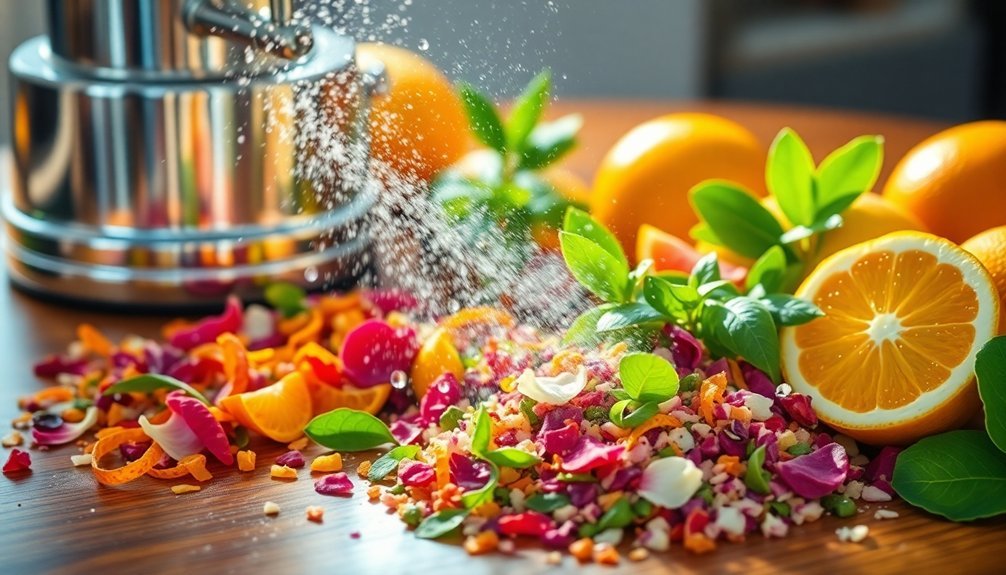
Unlike steam distillation's heated approach, cold pressing represents one of nature's purest methods for extracting botanical oils.
You'll find this mechanical process maintains temperatures below 120°C while using specialized equipment to grind and press raw materials, preserving their natural essence without any chemical additives.
When you're seeking the highest quality botanical oils, cold pressing offers these key advantages:
- Preserves the natural nutrients, flavors, and antioxidant properties that make these oils so valuable
- Uses environmentally sustainable methods that require less energy and zero harsh chemicals
- Maintains traditional extraction wisdom while incorporating modern refinements through equipment like screw presses and hydraulic systems
This time-honored technique, practiced since ancient civilizations, continues to deliver pure, potent oils that capture nature's authentic aromatic properties.
Traditional Enfleurage Techniques
The ancient art of enfleurage stands as one of perfumery's most delicate extraction methods, using pure fats to capture the essence of fresh flowers.
You'll find two main approaches: cold and hot enfleurage. In cold enfleurage, you'll place delicate flowers like jasmine and daffodils on glass trays coated with coconut oil or similar fats, replacing the blooms daily until the fat becomes fully scented.
Hot enfleurage works differently – you'll heat oils like moringa or olive oil in a bain-marie with heat-resistant flowers such as roses and mimosa.
While modern techniques have largely replaced this labor-intensive process, enfleurage is experiencing a revival among natural perfumers.
It's particularly valuable for extracting scents from fragile flowers that can't withstand other extraction methods, yielding unique and subtle fragrances.
Sustainable Plant Material Selection
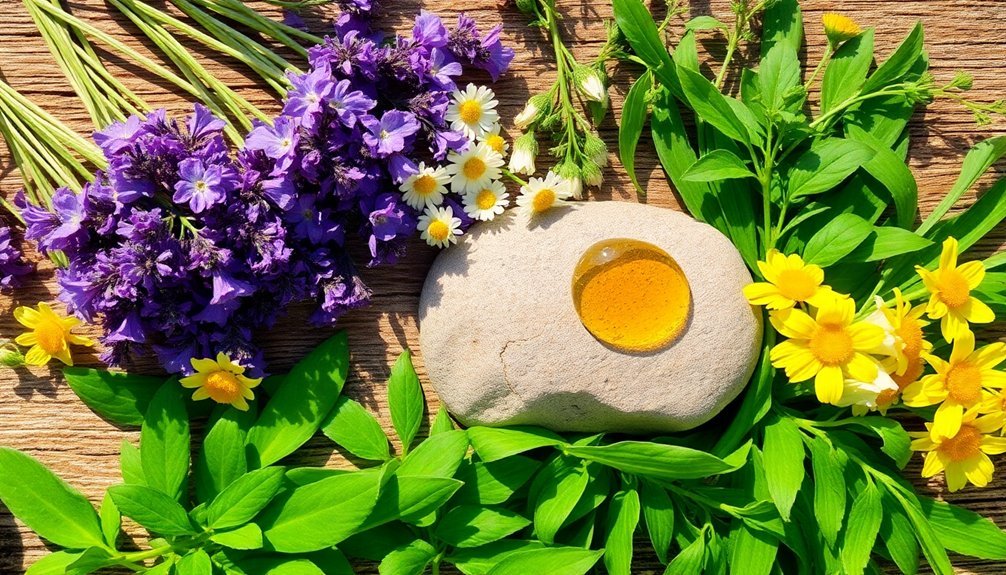
When you select plants for natural perfumery, you'll want to prioritize those grown through ethical harvesting practices that protect both the environment and local communities.
Local growing methods reduce carbon footprints while supporting regional farmers and ensuring fresher, more potent botanical materials.
Native plant selection plays an essential role in maintaining biodiversity and requires less water and fewer resources, making it an environmentally responsible choice for sustainable perfume creation.
Ethical Harvesting Practices
Sustainable perfume production starts with ethical harvesting practices that protect both plant species and local communities.
You'll find that responsible perfume makers prioritize careful cultivation methods that preserve plant populations while supporting the farmers who tend them.
These ethical practices include:
- Implementing water conservation techniques for water-intensive crops like roses
- Using organic and regenerative farming methods to maintain soil health
- Supporting fair labor practices that provide sustainable income for rural communities
When you choose pure plant perfumes from ethical sources, you're supporting traditional farming practices and helping preserve biodiversity.
The careful harvesting of sensitive ingredients like sandalwood and frankincense guarantees these precious resources will be available for future generations while providing economic stability to the communities that cultivate them.
Local Growing Methods
Modern local growing methods offer an extensive approach to sustainable perfume production through carefully selected plant materials and innovative cultivation techniques. You'll find these methods prioritize biodiversity while reducing environmental impact through regenerative practices.
| Growing Method | Key Benefit | Environmental Impact |
|---|---|---|
| Biodynamic | Respects natural cycles | Low soil disruption |
| Rainwater Systems | Water conservation | Reduced groundwater use |
| Solar-Powered | Energy independence | Zero emissions |
| Leguminous Plants | Soil regeneration | Carbon sequestration |
When you choose locally grown perfume ingredients, you're supporting techniques that use up to 75% less water and reduce carbon emissions by 80%. These methods embrace native plant species and patented technologies that protect local ecosystems while ensuring sustainable production cycles. Biotechnology advancements now allow for lab-grown botanical matter, further reducing pressure on wild plant populations.
Native Plant Selection
Three key principles guide native plant selection in pure plant perfumery: biodiversity protection, ecological balance, and sustainable harvesting practices.
You'll find that selecting native plants for perfume creation helps preserve local ecosystems while ensuring the survival of diverse plant species for future generations.
- Choose plants that thrive naturally in specific climatic conditions, like jasmine, which doesn't require chemical interventions to flourish.
- Select species that support traditional farming techniques, reducing the need for synthetic fertilizers and excessive water usage.
- Work with plants that enable sustainable harvesting methods, such as sandalwood, where careful extraction practices protect future populations.
When you opt for native plant ingredients, you're supporting local communities through fair wages and helping maintain the delicate balance of regional ecosystems.
Natural Solvent Extraction Methods
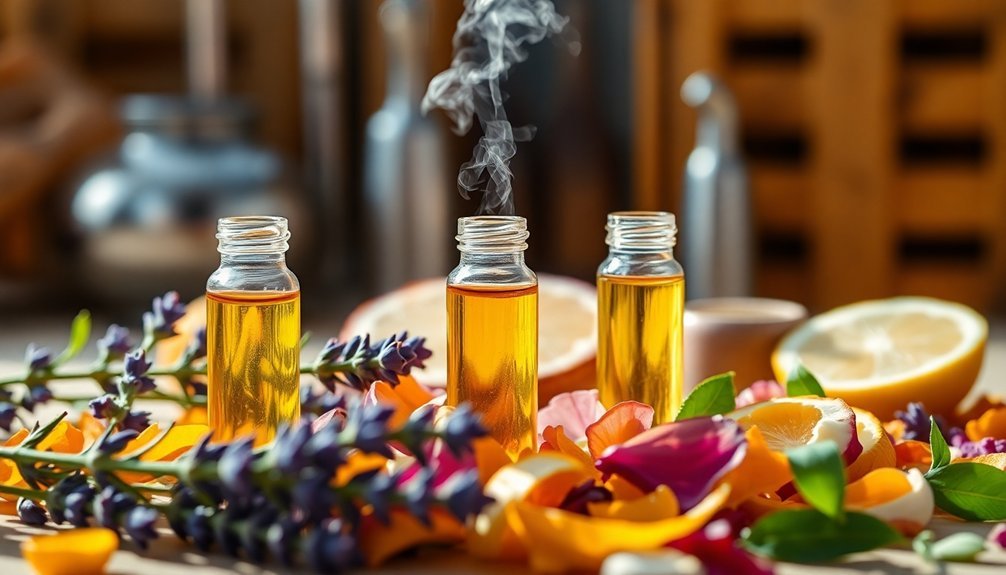
Natural solvent extraction stands as one of perfumery's most effective methods for capturing delicate floral aromas. You'll find it's particularly useful for flowers with low oil content, as it efficiently preserves complex fragrance compounds while maintaining their authentic scent profiles.
When you're working with fragile plant materials, this method offers significant advantages. It's gentle on heat-sensitive compounds and gives you the flexibility to selectively extract specific aromatic molecules by adjusting your solvent conditions.
However, you'll need to take into account the challenges of residual solvents. There's always a risk of petroleum-like traces in your final product if it's not properly purified.
While traditional techniques like enfleurage and maceration are still available, they're less common today. These older methods use natural fats or oils but require more time and labor than modern solvent extraction.
Maturation and Aging Processes
While creating pure plant perfumes requires careful ingredient selection, the maturation process plays an equally essential role in developing their full aromatic potential.
You'll find that maturation transforms distinct fragrance notes into a harmonious blend, much like aging fine wines. During this process, your perfume rests in a controlled environment, allowing the components to merge and develop greater complexity.
- The maturation period can last from weeks to months, depending on your perfume's complexity.
- You'll notice how top, middle, and base notes integrate to create a more sophisticated scent.
- The process works best in stable temperatures away from light, with occasional gentle agitation.
This careful aging complements the maceration process, where you've extracted essential oils from plant materials.
Together, these methods guarantee your pure plant perfume achieves its intended depth and character.
Blending Pure Plant Extracts
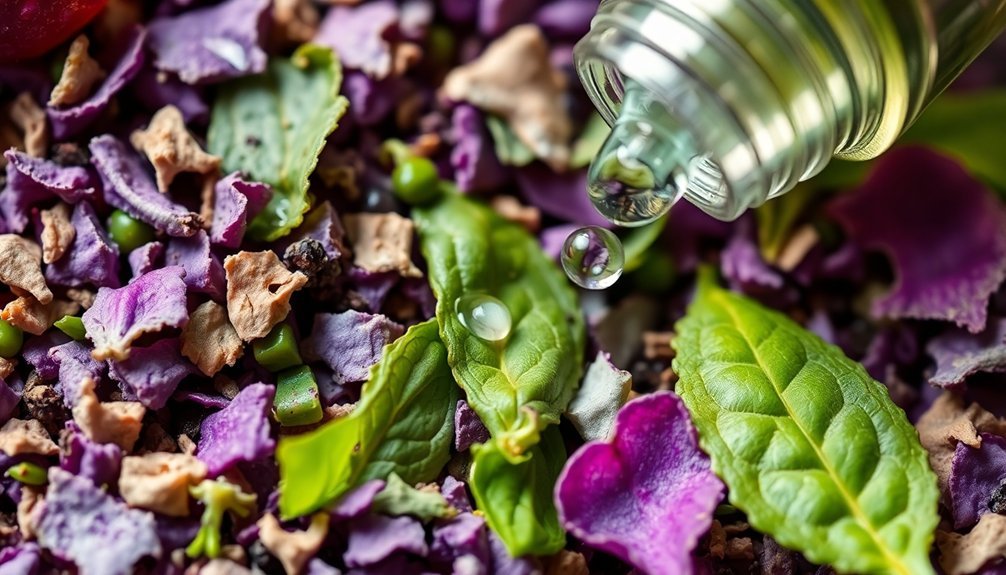
Building upon the art of maturation, the precise blending of pure plant extracts forms the heart of natural perfumery.
You'll need to understand the three fundamental notes – top, middle, and base – and how they interact to create a harmonious scent profile.
Start by setting up your blending station with amber glass bottles, pipettes, and test strips. You'll want to dilute your essential oils with carrier oils like sweet almond or grapeseed oil, as they're highly concentrated.
Keep detailed notes of your combinations and ratios for future reference.
When you're experimenting with different blends, remember to reset your olfactory system using coffee beans or fresh air between tests.
Try classic combinations like lavender and rose geranium for relaxation, or grapefruit and lemon for energy.
Let your blends mature for several days to understand how their scents develop.
Storage and Preservation Guidelines
To preserve your pure plant perfumes, you'll need to maintain a consistent temperature between 15-20°C in a dedicated storage space away from heat sources.
Your perfumes should be stored in dark glass bottles with tight-fitting lids to protect against UV rays and prevent oxidation.
Choose storage containers that not only shield your perfumes from light but also minimize air exposure to maintain the integrity of your botanical blends.
Temperature Control Essentials
Since temperature plays a vital role in preserving plant-based perfumes, proper storage conditions are essential for maintaining their quality and fragrance.
You'll want to keep your perfumes at around 15 degrees Celsius – similar to a spring morning – to prevent chemical degradation and maintain their olfactory qualities.
High temperatures and heat exposure can quickly break down your perfume's molecular structure, diluting its scent and altering its original fragrance.
To protect your investment, follow these key temperature control practices:
- Store your perfumes in a consistently cool environment away from direct sunlight
- Avoid placing bottles near heat sources like stoves, ovens, or heaters
- Don't subject your perfumes to sudden temperature changes, such as frequent transfers between room temperature and refrigeration
Light and Container Selection
Proper light exposure and container choice work hand-in-hand with temperature control to protect your plant-based perfumes. You'll want to store your fragrances in a cool, dark place away from windows and direct sunlight, as UV rays can break down essential oils and alter the scent profile.
| Factor | What to Do | What to Avoid |
|---|---|---|
| Container | Use glass bottles | Plastic or metal |
| Closure | Choose tight seals | Loose or damaged caps |
| Light | Store in dark places | Window exposure |
| Storage | Keep in cool spots | Heat sources |
When selecting containers, opt for recyclable glass bottles with secure spray nozzles or caps. Glass doesn't react with the fragrance compounds, helping maintain the perfume's integrity. Remember, a proper seal prevents volatile compounds from escaping and stops air from oxidizing your precious plant-based scents.
Environmental Factors in Scent Release
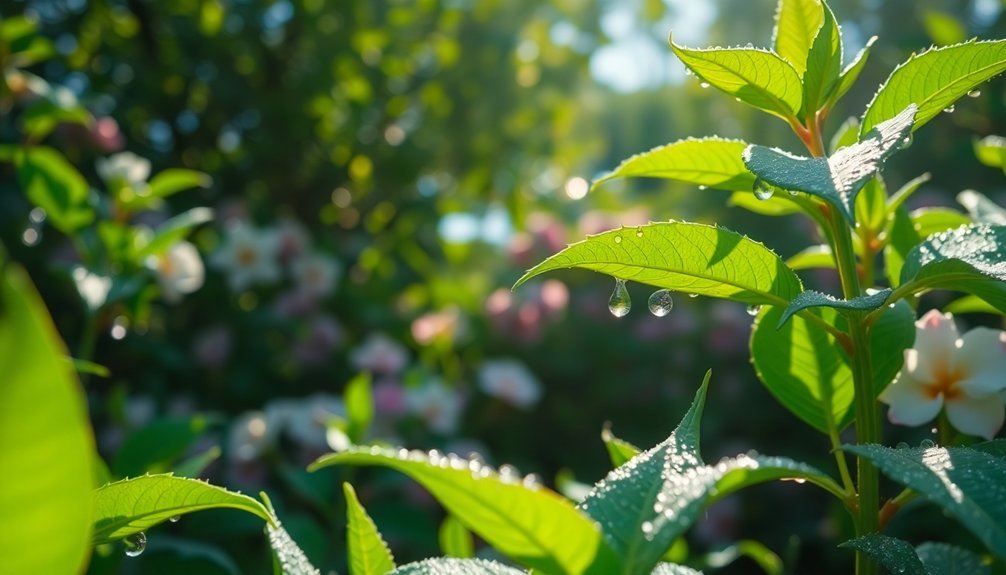
While flowers may appear to release their fragrances at random, several key environmental factors determine when and how strongly plants emit their scents.
Temperature, sunlight, and humidity work together to orchestrate this delicate process, with warm sunny days creating ideal conditions for fragrance release.
You'll notice the strongest scents when environmental conditions align perfectly:
- Warmer temperatures and direct sunlight boost enzyme activity, enhancing the production and release of essential oils.
- Lower humidity levels allow fragrances to disperse more freely through the air, making scents more noticeable.
- Well-maintained soil moisture supports the metabolic processes necessary for creating these aromatic compounds.
Your local climate and seasonal changes also play significant roles, affecting both the timing and intensity of fragrance production throughout the year.
Frequently Asked Questions
Can Wearing Pure Plant Perfumes Affect Our Mood or Mental State?
Yes, you'll feel mood changes when wearing pure plant perfumes because they trigger your limbic system, releasing neurotransmitters like serotonin and dopamine. Different scents can help you feel relaxed, energized, or calmer.
Do Plant Perfumes Interact Differently With Individual Body Chemistry?
Yes, your unique skin pH, body temperature, and metabolism make plant perfumes smell differently on you. Your genetics, hormones, and even diet can affect how the fragrance interacts with your personal chemistry.
Why Do Some People Experience Allergic Reactions to Natural Plant Perfumes?
You can experience allergic reactions to natural plant perfumes because they contain volatile organic compounds that may trigger your immune system. Your sensitivity to specific botanical allergens and irritants determines your reaction level.
How Long Can Pure Plant Perfumes Maintain Their Original Scent Profile?
You'll find pure plant perfumes can maintain their original scent for several years if you store them properly. Keep them in cool, dark places, and avoid exposing them to light, heat, and humidity.
Are Plant Perfumes More Environmentally Friendly Than Synthetic Alternatives?
Yes, you'll find plant perfumes are typically more eco-friendly. They're biodegradable, support sustainable farming, and reduce chemical pollution. However, you should verify sustainable sourcing practices to avoid issues like overharvesting natural ingredients.
In Summary
You'll find that pure plant perfumes release their scents through a fascinating combination of science and nature. Volatile organic compounds in essential oils need proper carriers, extraction methods, and storage conditions to maintain their potency. Whether you're using steam distillation or cold pressing, understanding these processes helps you preserve the delicate fragrances. Temperature, light, and air exposure all play vital roles in how plant scents reach your nose.

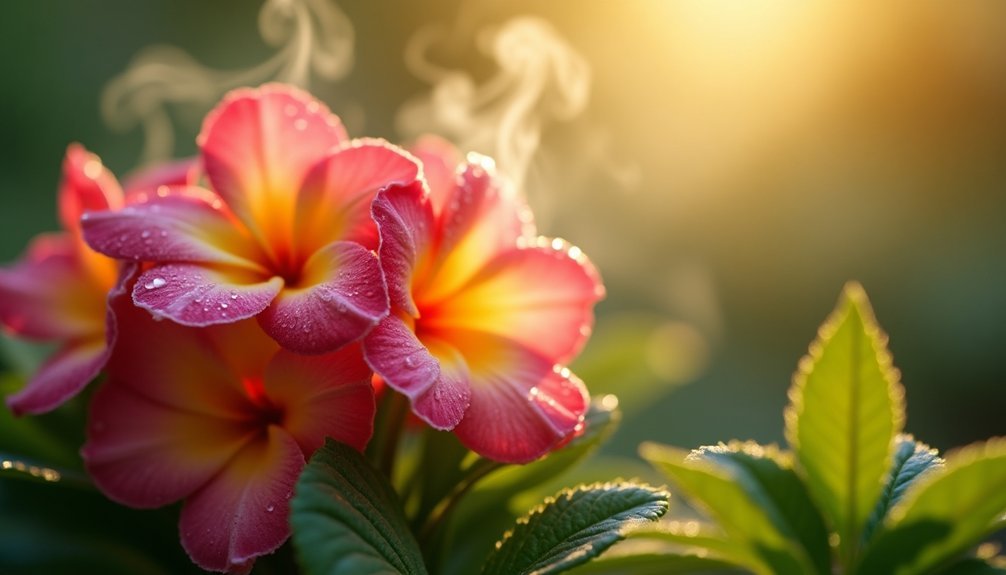
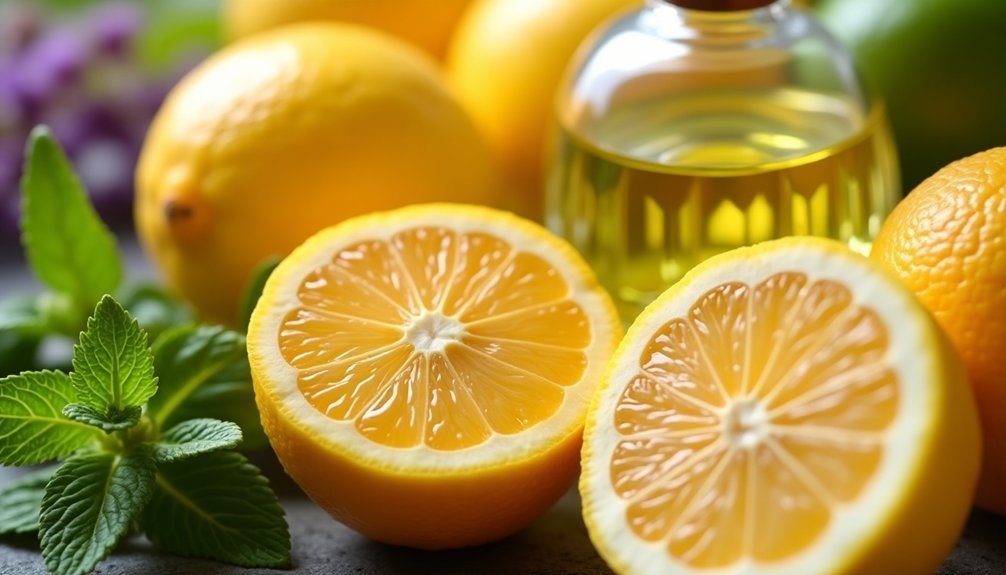
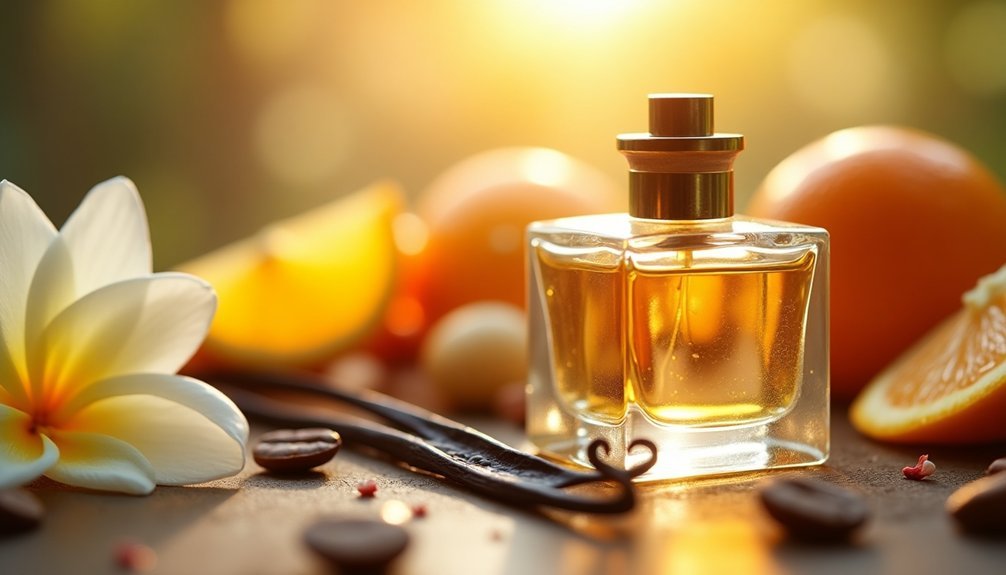

Leave a Reply